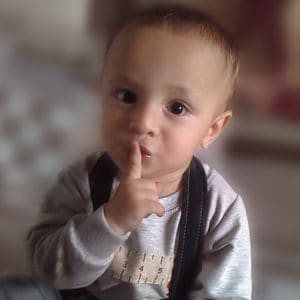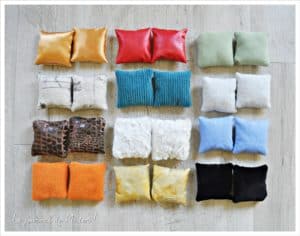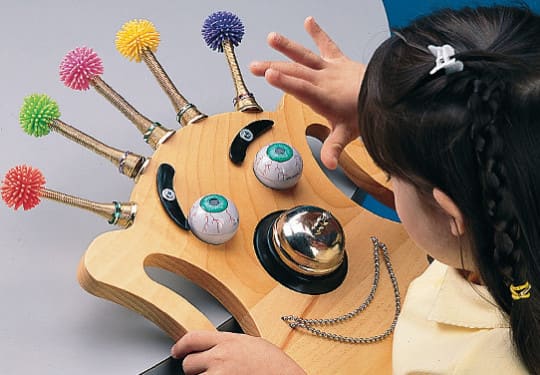
18 Sensory Activities for Toddlers and Preschoolers You Can Do At Home

Sensory Activities at Home
When new parents hear the terms “Montessori activities” or “sensory activities”, they immediately have the impression of expensive, messy, and complicated to implement at home. Many parents leave it up to the school or daycare to do these sensory play activities. However, it doesn’t have to be hard.
The activities we have down below are simple to do at home but are based on the same Montessori principles as the more expensive and complex tools you would see in a Montessori classroom. Happy Montessori!
Sensory Activities – Sight
Although the following ideas are primarily activities that stimulate your child’s sight, many will require him to use other senses simultaneously.
With these activities, your child will learn about colors, shapes, and sizes.
Stacking blocks (18 months to 3 years)

A good visual sensorial activity involves a set of wooden stacking blocks that are graduated in size. Look for blocks or cups that nest inside each other and stack into a tower that is satisfying to build and also fun to store away neatly afterward. Children learn concepts such as smaller and bigger while they play. In Montessori schools, children around age three are shown how to use a set of 10 precisely graded blocks to build a “pink tower”.
Geometric shape stacker (2 to 4 years)
There are many variations on this toy, but most have one or more spindles and sets of pieces. Once the pieces are removed, the challenge is for your child to find the pieces that are alike, i.e. squares, octagons, and circles. She then finds the largest piece within that set and places it on the spindle at the bottom. She continues until all of the pieces have been placed. Your child should be able to recognize for herself if she made a mistake because a larger piece placed over a smaller one will hang over, and will not look right.
Sorting objects (2 to 5 years)
 Sorting objects according to shape, size, color, or other physical properties is a rewarding sensory activity that challenges young children to pay close attention to the task and to make some logical choices. For this activity, all you need are several examples of some sort of appealing object in various shapes, colors, and sizes.
Sorting objects according to shape, size, color, or other physical properties is a rewarding sensory activity that challenges young children to pay close attention to the task and to make some logical choices. For this activity, all you need are several examples of some sort of appealing object in various shapes, colors, and sizes.
For younger children, be cautious about the size of objects you choose, make sure they can’t swallow them or push them into nostrils or ears. Sets of bricks in different shapes and colors work well for toddlers.
A good example of this activity for a 3 or 4-year-old is button sorting. Get some buttons or select several different sets of four or more identical buttons. Mix the buttons together in a large bowl then show your child how to select one button, place it in a smaller bowl, and then find all of the other buttons that match.
Simple puzzles (2 to 5 years)
Simple puzzles are popular amongst young children. Always look for puzzles with attractive images, and that is made from wood. Avoid puzzles made of cardboard and those that do not fit into a frame for each piece. For children under the age of three, use puzzles with a large knob for each piece for easy handling. Remember, let your child do the play, resist the temptation to fit the pieces yourself.
Matching paint swatches (3 to 5 years)
 Montessori schools use prepared sets of wooden tablets painted with various colors to help children learn to distinguish between primary and secondary colors and tones, while also mastering the words used to describe each color and shade. You can do the same at home simply by gathering paint swatches from your local hardware store.
Montessori schools use prepared sets of wooden tablets painted with various colors to help children learn to distinguish between primary and secondary colors and tones, while also mastering the words used to describe each color and shade. You can do the same at home simply by gathering paint swatches from your local hardware store.
You can create three sets of color swatches. All the swatches should be the same size, differing only in color. For younger children, start with a set of six color swatches, two each of bright yellow, red, and blue. Ask your child to match the pairs and learn the names of these primary colors.
When your child can manage these, collect a second set of 11 pairs of primary and secondary color and tones: yellow, red, blue, green, orange, purple, pink, brown, gray, white, and black. Invite your child to match and name them.
For a more difficult challenge, build a third set containing seven different shades of each of nine different colors (yellow, red, blue, green, orange, purple, pink, brown, and gray), which your child learns to sort in order from the lightest to the darkest shade. When all of the swatches are laid out in an array it creates a lovely display of color.
There are many ways in which you can make this work more challenging still. For example, ask your child to find the color swatch that is closest in color to something in the room.
Another challenge is to show your child a color swatch from the third set and ask him, by memory alone, to point to the swatch that is just one shade lighter or darker.
A third activity, with older children, would be to teach them how to create lighter or darkest shades of paint by adding white or black to an existing color. By beginning with the pure color and adding a bit more white and mix it up, they can create a series of daubs of paint from darkest to lightest, similar to paint swatches. Repeat using black.
Concentration game (3 to 5 years)
This game helps children develop their visual memory and pattern recognition skills. You can buy various versions at most toy stores, or you can make your own. For our family, my 3-year-old son is especially attracted to superheroes, so I made my own set of superhero memory game for him, and it was a great him.
To make a set, cut out 16 pieces of thin cardboard or cardstock the size of standard playing cards. Either draw or cut out two identical copies of eight different geometric shapes. Pictures of animals or something your child like can also be used. Glue a shape or picture onto each card. You now have 16 identical-sized cards, made up of eight pairs of different shapes or pictures.
To play the game, mix up the cards and place them face down in a square made up of four rows down with four cards across in each row. The first player turns over two cars, one at a time. If they match, that player keeps the pair. If they don’t match, the player turns them face down again. Players attempt to remember which card is in which position, making it more likely that they will find matching cards when it is their next turn. The game continues until all cards have been matched.
As your child becomes better at this game, you can make new sets with different designs or images, and you can increase the challenge by adding more pairs to the set and by not arranging them in rows. For us, we are now on our set of 24 cards!
Sensory Activities – Sound
As your child gets older and his hearing develops, he can learn to distinguish between different sounds and also pinpoint where a sound is coming from. Here are some sound-related sensory activities for toddlers and preschoolers.
Dried lima beans (18 months to 4 years)
Find a large salad bowl that is made of heavy pottery or glass and fill it halfway with dried beans. Dried lima beans are good since they are too large to go into your child’s nose or ears, and they make a pleasant sound when dropped into the bowl.
Give you child a small ladle to show him how to use it to scoop up some beans, then empty the ladle back into the bowl Allow very young children to play with the beans. As they swish their hands around in the bowl, the beans feel nice and make an interesting sound. If your child knocks some out, show him how to pick them up and return them to the bowl. Stress the importance of getting all the beans back into the bowl for easy clean up. At first, don’t be surprised if the beans spill all over. Simply show your child the correct way to put them back, using patient, kind language.
Listening to music (18 months to 6 years)
 As your child gets older, you can play all sorts of musical games with her. You can sing or hum loudly along with the music, encouraging your child to do so as well. You can clap your hands to the beat and you can dance freestyle in response to music, swaying twirling gently, or dancing in any way that feels right for the music playing.
As your child gets older, you can play all sorts of musical games with her. You can sing or hum loudly along with the music, encouraging your child to do so as well. You can clap your hands to the beat and you can dance freestyle in response to music, swaying twirling gently, or dancing in any way that feels right for the music playing.
Studies show the value of offering very young children a variety of music in a broad range of tones and pitches. Children begin to distinguish differences in music much as they become able to distinguish their native language from a foreign language.
Start to teach your child to recognize the instruments that are being played in a particular piece of music, as well as teaching her the name of tunes or even composers. For example, “Swan Lake is playing on the radio!”. Make sure your child has access to lots of instruments that she can play, i.e. xylophone, drums, guitar, piano, and encourage her to sing along with favorite tunes.
During these years, your child is in a sensitive period for music and has a spontaneous interest in the development of pitch, rhythm, and melody. Musically talented parents who expose their children to live music tend to produce children who are musically gifted. Listening to classical music is another way to stimulate your child’s musical sense. Early signs of precocious talent include remembering melodies, humming or singing a tune, rhythmic ways of moving and speaking, and tapping rhythmically.
Matching bells (3 to 5 years)
For this activity, you will need to gather 8 or more pairs of bells, each pair having the same sound. Because the bells may look different, your child will need to do this activity with her eyes closed or blindfolded. And eyes closed, your child’s attention is focused on the sound of bells, helping her to match the pairs.
You are likely to find two types of bells: those with handles and those that are normally sewn or fixed onto something, such as clothing or a horse’s harness. The second type is difficult for young children to work with because the ring of the bell is muffled by their hands as they hold it. You can solve this problem by tying a ribbon to the bell. Your child picks it up by the ribbon with one hand and shakes it, or strikes it with the other hand to make it ring.
Your child rings one bell and sets it aside. She then picks up another bell and rings it to see if it is the same. You may want to ring the first bell again to refresh her memory. If the first bell she tried is not the right match, she sets it aside, selects another and listens to that one for a match. When she finds the right bell, she can set the two matching bells to one side together. She then goes on to select another bell, and repeats the process until she finds the match for each bell.
The Silence Game (2 to 6 years)
 In our everyday environment, it seems that silence is almost unknown. We are almost always surrounded by some type of sounds. It is a great gift to help your child discover the beauty that can be found in silence. When silent we can hear our own thoughts, meditate, and become much more aware of the world around us.
In our everyday environment, it seems that silence is almost unknown. We are almost always surrounded by some type of sounds. It is a great gift to help your child discover the beauty that can be found in silence. When silent we can hear our own thoughts, meditate, and become much more aware of the world around us.
The silence game helps children develop a much higher level of self-discipline, along with a greater awareness of the sounds around them that most people take for granted. In this activity, get your children’s attention either by ringing a small bell or by giving a familiar hand signal to begin a game of “silence”. Your child should stop what they are doing, sit down, close their eyes, and try to remain perfectly still. Challenge them to stay like this until they hear you whisper their name. When each child hears his or her name spoken softly, he or she should silently rise and join you. You might want to vary the silence game and help your children learn to move carefully and quickly by challenging them to carry bells across the room without allowing them to ring.
At first, younger children may not be able to remain still and silent for more than 30 seconds, but gradually, your child will develop the ability to relax, listen, and appreciate silence. If your children enjoy this game, make it a daily ritual. Another variation is guided visualization, a process by which your children close their eyes and you describe a scene in front of them for them to imagine: “Now we are walking down the beach. We put our toes in the water. Oh my, it’s so cold!”
Sound Cylinders (3 to 6 years)
This is an exercise to help children develop the ability to discriminate between sounds involves using a set of sound cylinders. You can make these from any wooden, plastic, or glass containers that you find around the house. The containers need to be opaque so you cannot see what’s inside, and they need to produce a clear sound when they are filled with different objects when shaken. Small glass jars, such as baby food jars, can be used if you paint the insides of them or lined them with colored paper to make the walls opaque.
Six containers should be painted one color, and the other six a second color. Fill pairs of the jars (one jar of each color) with something that will make an interesting sound when rattled or shaken, i.e. dried beans, beans, rice, sand. The children then try to match each cylinder of one color with the cylinder of another color with the same sound. In Montessori schools, each set of six jars of one color is housed in a box with a lid painted the same color.
Sensory Activities – Touch
There are many ways to train children’s sense of touch. As babies, we have introduced the ultimate sensory activity that focuses on all 5 senses – the basket of treasures. As our babies grow into toddlers and preschool children, their sense is now refined, and they will be ready to attempt some more challenging activities.
Texture matching (3 to 5 years)
 This game is ideal for helping to develop your child’s sense of touch. Typically, it consists of a set of small tablets or blocks of wood with a distinct texture on one face, created by pasting a piece of fabric, Velcro, seeds, sand, and other substance to that surface. You will need two matching blocks for each texture, creating pairs that feel the same when touched. When the textured side is turned downward, the blocks all look the same. With his eyes closed or blindfolded, ask him to try to “see” with his fingertips, finding the matching pairs. When turned over, the textured sides of each pair match, which provides a visual key so your child can see if he has guessed correctly.
This game is ideal for helping to develop your child’s sense of touch. Typically, it consists of a set of small tablets or blocks of wood with a distinct texture on one face, created by pasting a piece of fabric, Velcro, seeds, sand, and other substance to that surface. You will need two matching blocks for each texture, creating pairs that feel the same when touched. When the textured side is turned downward, the blocks all look the same. With his eyes closed or blindfolded, ask him to try to “see” with his fingertips, finding the matching pairs. When turned over, the textured sides of each pair match, which provides a visual key so your child can see if he has guessed correctly.
Fabric matching (3 to 5 years)
 A variation on the above concept involves a basket filled with squares of different kinds of fabrics, silk, wool, cotton, tweed, and so on. Prepare matching pairs of each type of fabric. With his eyes closed or blindfolded, ask your child to try to find the pairs of fabric squares that feel the same and to lay them together on the table. When he opens his eyes, he can visually check his work.
A variation on the above concept involves a basket filled with squares of different kinds of fabrics, silk, wool, cotton, tweed, and so on. Prepare matching pairs of each type of fabric. With his eyes closed or blindfolded, ask your child to try to find the pairs of fabric squares that feel the same and to lay them together on the table. When he opens his eyes, he can visually check his work.
Sandpaper tablets (3 to 5 years)
The sandpaper tablets consist of a set of six pairs of wooden tablets with each pair covered with a different grade of sandpaper. Your child attempts to identify pairs that have the same roughness, working by touch alone, with his eyes closed or blindfolded. When he has finished matching the tablets, he can check his work by turning them over. The matching pairs will look the same.
The mystery bag (3 to 6 years)
 The mystery bag has been a favorite sensory activity for many children. Usually, it is simply a cloth bag or box with a hole for your child’s hands, through which she can touch and manipulate objects that she cannot see. To play, you need a collection of small, familiar objects that your child can name. While she closes her eyes, place an object inside the bag and challenge her to identify it by touch alone. If your child guesses correctly, switch roles and allow her to choose the mystery object. Make the game more challenging for older children by using different coins, shells, or geometric shapes.
The mystery bag has been a favorite sensory activity for many children. Usually, it is simply a cloth bag or box with a hole for your child’s hands, through which she can touch and manipulate objects that she cannot see. To play, you need a collection of small, familiar objects that your child can name. While she closes her eyes, place an object inside the bag and challenge her to identify it by touch alone. If your child guesses correctly, switch roles and allow her to choose the mystery object. Make the game more challenging for older children by using different coins, shells, or geometric shapes.
This game relies on touch alone, but it is a great vocabulary builder too. Children can describe the shapes and texture they are feeling using words like hard, smooth, round, and bumpy.
Sensory Activities – Smell
Children have a much more sensitive sense of smell than most adults. Here are two exercises to help your child refine her perceptions and learn to recognize and name different aromas.
Perfume bottles (3 to 5 years)
These consist of a set of 12 small, identical plastic or glass containers with lids. Cylindrical spice jars with screw-on caps are ideal; you can also use baby food jars. You are going to create two identical sets of six jars. Cover one set of jars with blue paper and the other set with green. Put a cotton ball inside each jar and place a drop or two of the same perfume on the cotton ball of one green and one blue jar. Use different scents for each of the six pairs of jars. You might use aromatic liquid flavorings such as vanilla, almond, peppermint, lemon, or eau de cologne. In some , you could skip and cotton ball and use something solid that has a strong and pleasant scent, such as potpourri, spices such as cloves, and cinnamon, chocolate, a strawberry, or orange or lemon rinds. In this case, you need to be sure that your child cannot see what’s inside the jar. Remember, these substances will dry out and loses their aroma after a while, so you will need to refresh time from time to time. Your child selects a jar from one set, opens a lid, and sniffs the scent. She then finds the matching jar from the other set. She sets the two jars aside and repeats the process with the remaining jars.
Herb scents (3 to 5 years)
 If you have an herb garden, or just a few small pots of herbs on the kitchen window, you already have a ready-to-go sensory activity at home. You can offer some rich sensory experiences with aromatic herbs such as rosemary, lavender, basil, and thyme. It will be even more satisfying if your child has grown some of the plants herself. Children enjoy using a small mortar and pestle to crush herbs for cooking. You can also dry herbs together and experiment with scents to make bowls of potpourri or small sachets to put in drawers.
If you have an herb garden, or just a few small pots of herbs on the kitchen window, you already have a ready-to-go sensory activity at home. You can offer some rich sensory experiences with aromatic herbs such as rosemary, lavender, basil, and thyme. It will be even more satisfying if your child has grown some of the plants herself. Children enjoy using a small mortar and pestle to crush herbs for cooking. You can also dry herbs together and experiment with scents to make bowls of potpourri or small sachets to put in drawers.
Sensory Activities – Taste
There are four basic tastes that we can sense with our tongues: sweet, sour, salty, and bitter The most basic way to introduce the concept of taste is to talk about different foods. For example, you can say, “This apple is so sweet!” or “I think the popcorn is very salty”! What do you think?” Some children are extremely fussy about eating foods that have a strong or unfamiliar flavor. You may find that your child becomes more willing to try new foods as he explores new scents and tastes through sensory play experiences. To start with, gradually introduce each taste with different foods. For example, you might introduce bitter by offering your child a tiny bit of rocket or some parsley. Another activity you can play with your child to stimulate the sense of taste is to suggest your child pay close attention to the taste of certain foods. For example, you can say “Oh my, just taste and smell the ginger in this gingerbread cookie!”. You can suggest your child to close his eyes, take a taste of something, and try to name what the taste is. You can also make tasting bottles.
Tasting bottles (3 to 5 years)
 Gather 6 small bottles with squeeze droppers and paint the lids of three bottles blue and the other three red. Now you have two sets of three dropper bottles. Fill one bottle from each set with a liquid that represents one of the basic tastes. For example, sugar water (sweet), lemon juice (sour), and salty water (salty). Your child should wash her hands, line up each set of bottles, then carefully unscrew the top from one bottle and put a small drop on the back of her left hand. Ask her to lick it slowly to get the taste. Now she chooses a bottle from the second set, unscrews the lid, and puts a small drop of the tip of one finger on her right hand. Does it taste the same? No? set this bottle aside, and repeat the process until she finds the match, then remove both matching bottles and set them aside. Your child needs to wash her hands before returning to the remaining bottles and repeating the process. When all three pairs have been matched, the game is done!
Gather 6 small bottles with squeeze droppers and paint the lids of three bottles blue and the other three red. Now you have two sets of three dropper bottles. Fill one bottle from each set with a liquid that represents one of the basic tastes. For example, sugar water (sweet), lemon juice (sour), and salty water (salty). Your child should wash her hands, line up each set of bottles, then carefully unscrew the top from one bottle and put a small drop on the back of her left hand. Ask her to lick it slowly to get the taste. Now she chooses a bottle from the second set, unscrews the lid, and puts a small drop of the tip of one finger on her right hand. Does it taste the same? No? set this bottle aside, and repeat the process until she finds the match, then remove both matching bottles and set them aside. Your child needs to wash her hands before returning to the remaining bottles and repeating the process. When all three pairs have been matched, the game is done!
Importance of Sensory Stimulation
It is important to continue to educate young senses. By implementing these simple-to-do sensory activities at home for your toddler and preschooler, you can help your children learn to see, hear, touch, taste, or smell what they experience with a deeper appreciation.
We hope you find this article on sensory activities useful. If you are interested, you can read more on our article on sensory activities for babies, and how sensory activities boost brain power in children. Please share with us any ideas of raising sensory awareness in toddlers and preschoolers by commenting down below!

Love Baby Mozart?
Follow us on Social Media!
Subscribe today to get exclusive advice on our latest parenting tips, brain development tools, music and songs updates, and much much more! Remember, it's 100% FREE!


